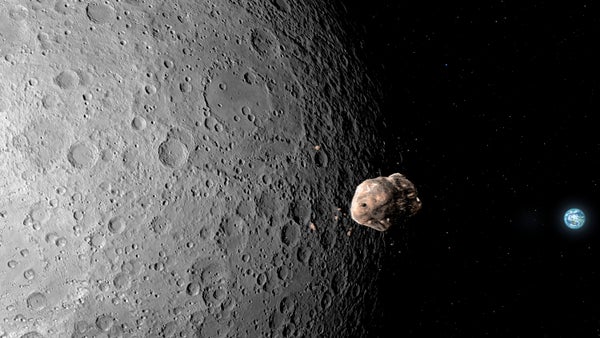April 3, 2025
2 min read
New observations from the James Webb Space Telescope show that the potentially hazardous asteroid 2024 YR4 is a building-sized space rock

This artist’s concept shows a small asteroid passing Earth’s moon.
Mark Garlick/Science Photo Library/Getty Images
For a few weeks in January and February this year, asteroid 2024 YR4 had us all worried.
Shortly after it was discovered, astronomers calculated that the asteroid had a 1-in-83 chance of hitting Earth in 2032 — that’s an impact risk of around 1%. Experts urged caution, though noting that the impact odds were likely to fall significantly. Sure enough, by late February, the probability of the asteroid hitting Earth fell to near zero.
This asteroid, however, is still worth analysis in its own right. As such, scientists recently turned the James Webb Space Telescope‘s (JWST) powerful gaze towards 2024 YR4, capturing the object in both visible and thermal light. The team measured the asteroid to be around 200 feet (60 meters) in diameter. “That’s just about the height of a 15-story building,” Andy Rivkin of the Johns Hopkins University Applied Physics Laboratory said in a statement.
On supporting science journalism
If you’re enjoying this article, consider supporting our award-winning journalism by subscribing. By purchasing a subscription you are helping to ensure the future of impactful stories about the discoveries and ideas shaping our world today.
The JWST also helped scientists study how quickly the space rock heats up and cools down. According to Rivkin, these thermal properties in 2024 YR4 are “not like what we see in larger asteroids,” likely due to the fact that it spins very quickly and that its surface is “dominated by rocks that are maybe fist-sized or larger,” rather than fine grains of sand.

NASA’s James Webb Space Telescope recently captured these images of the asteroid 2024 YR4 using both its NIRCam (Near-Infrared Camera) and MIRI (Mid-Infrared Instrument). Data from NIRCam shows reflected light, while the MIRI observations show thermal light.
NASA, ESA, CSA, STScI, Andy Rivkin (APL)
Rivkin said studying asteroids like 2024 YR4 with the JWST is “invaluable” for helping scientists figure out how our space telescopes might aid planetary defense efforts if another “possible impactor” is found down the line.
“All together, we have a better sense of what this building-sized asteroid is like,” Rivkin said.
“This will help us determine the best approach to use during a more urgent observing program should another asteroid pose a potential impact threat in the future.”
A study about the JWST’s observations of asteroid 2024 YR4 were published in the journal Research Notes of the AAS.
Copyright 2025 Space.com, a Future company. All rights reserved. This material may not be published, broadcast, rewritten or redistributed.
